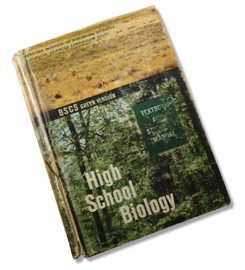May 16, 2009
Though Rachel Carson is usually credited for raising the public’s awareness of ecology, as Marion Clawson noted, it was Marston Bates’ 1960 book, The Forest and the Sea, not Silent Spring, that made “ecology a household word.”
Though remembered today for his very quotable quotes,” Bates was a serious critic who helped biologists move beyond promotion of the the technological fix.
In a series of books published between 1950 and the early 1960s, Marston Bates attempted to cut through the a thicket of progressionist pretenses and clear the ground for a new philosophy of science.
Dismissive of the popular pseudo-sciences of his day including still popular theories of climatic determinism and eugenic management, and equally skeptical of grand “evolving” ethical systems like Julian Huxley’s “evolutionary humanism,” Bates adopted Aldo Leopold’s idea of an “ecological conscience” as the new metaphysics, and promoted ecological diversity as a first principal.
Unfortunately, Bates, bathed in the apocalyptic writings of William Vogt and Harrison Brown, could not shed the view of human culture as an evolutionary mistake; a dangerous threat to the natural order.
Bates, like his contemporaries, believed the total number of humans alive represented a “density of population that exceeds all reason, all possibility of support.” And while Huxley and others could rationalize human population growth as at least providing the seeds for biological progress, Bates’ Darwinian fundamentalism provided no such escape. He was left with no choice but to characterize human population growth as a disease, a cancer that would inevitably kill its host.
We have, particularly in the last few centuries, escaped from the controls that maintain balance and proportion in the biotic community. We have run wild, like a weed escaped on a new continent. We have retained the birth rate that we acquired during our Pleistocene evolution through savagery, and at the same time radically altered the nature and the incidence of the factors causing death.
It was from this perspective that Marston Bates led the development of what was perhaps the most influential textbook of the 1960s, the BSCS “green version.”
 Outlined by Bates in 1960 and 1961, the BSCS “green version” presented a puckish inversion of the heroic themes of control of nature and conquest of disease by positioning humans not as the inevitable masters of nature, but as the inevitable destroyers of diversity.
Outlined by Bates in 1960 and 1961, the BSCS “green version” presented a puckish inversion of the heroic themes of control of nature and conquest of disease by positioning humans not as the inevitable masters of nature, but as the inevitable destroyers of diversity.
Interestingly, by the time this textbook was published in 1963, Bates philosophy had begun to mutate and evolve.
By the end of the 1950s, Bates began to admit he had come to something of a philosophical dead end. He wrote, “Intellectually I sympathize with the teachings of Buddha, that all life is sacred. But practically, I see no way of acting on this.” Ultimately, Bates was forced to take a leap of faith.
In a 1962 lecture delivered at Berkeley entitled “The Human Environment,” Bates introduced his audience to an idea he said he had been “turning around” in his mind for a few months, an alternative to anthropologist Peter Murdock’s “supernatural environment” that Bates labeled “the conceptual environment.” Bates’ search for a way past the dark conclusions of a metaphysics based on survival alone led him to consider the very odd folk-science of Vladimir I. Vernadsky and his noosphere.
This was Marston Bates’ moment of Zen.
Bates suggested that the “man-altered landscape” did not necessarily dictate the end of diversity, but might in fact lead to more diversity. Labeling it a “noosystem,” he suggested culture could be imagined as “an interacting complex like the ecosystem, but with a multiplying series of additional transactions involving that curious conceptual environment of the human species.”
Here, by extending the concept of ecological diversity to include the infinite diversity described by the sum of human interactions with the environment, Bates found a way to include his fellow humans in a framework in line with the “teachings of Buddha – that all life is sacred.” In doing so, Bates, consciously or not, closed the gap between his previously held fundamentalist view of the inevitable negative impact of a growing human population on ecological diversity, and Rachel Carson’s “other road,” her belief expressed in the last chapter of Silent Spring that an accommodation could be reached between Homo sapiens, in any number, and the natural world of which they were an evolving part.
